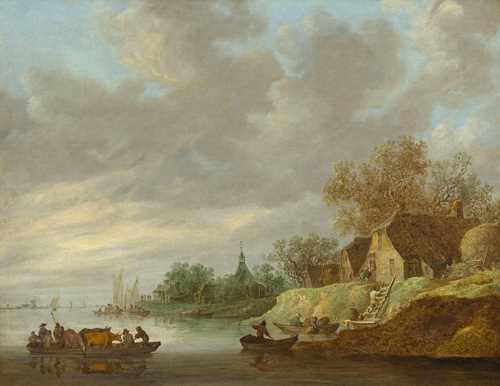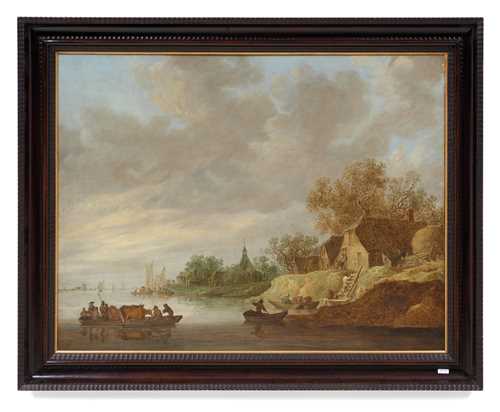
拍品 3045* - A200 大师画作 - Freitag, 01. April 2022, 02.00 PM
JAN VAN GOYEN
(Leiden 1596–1656 The Hague)
River landscape with ferry. 1641.
Oil on canvas.
Signed and dated centre bottom: VGoyen 1641.
79 × 94 cm.
Provenance:
- Collection of Carel F. L. de Wild, New York, 1922.
- With L. Morant, London, 1931.
- With D. A. Hoogendijk, Amsterdam, 1931.
- Collection of J. J. Th. Blijdenstein, 1931.
- Sale Sotheby's, London, 14.12.2000, Lot 42.
- European private collection.
Literature:
Hans-Ulrich Beck: Jan van Goyen, Amsterdam 1973, vol. II, p. 280, cat. no. 619.
The river landscape with a ferry offered here is a characteristic early work by Jan van Goyen, from the 1640s. This creative period in van Goyen’s work is characterised by broad horizontal landscapes, in which he places the horizon in the lower third of the picture, with a busy scene in the foreground and a topographical view in the background. This is impressively demonstrated in this Dutch river landscape with ferry crossing, dated 1641, which epitomises the artist’s ability to create wonderful atmospheric effects and represents the culmination of the development of his own style, after breaking away from the influence of his teacher Esaias van de Velde (1587–1630) in the 1630s.
Born in Leiden as the son of a shoemaker, according to the Leiden Chronicle of Jan Jansz. Orlers (1570–1646), he first studied with the local glass painters Coenraet van Schiperoort (1577–1636), Isaac van Swanenburgh (1537–1614), Cornelis Claesz. Clock (c. 1561–1629) and Jan Arentsz de Man (c. 1565–1625), and then in Hoorn with Willem Gerritsz. (c. 1582–c. 1628). After a one-year stay in France between 1615–16, van Goyen completed his training in the Haarlem studio of Esaias van de Velde. In 1618 he settled in Leiden and married Anna Willemsdr. van Raelst. In 1634 van Goyen moved permanently to The Hague, where he was admitted to the Guild of St Luke. He was appointed head of the Guild in 1638 and 1640.
Van Goyen specialised in the depiction of landscapes, always enlivening his views of villages, rivers, canals, beaches and coastal scenes with simple country people engaged in everyday activity. Boats – often ferry boats carrying passengers and loaded with cargo – are depicted, as in the painting offered here. The same village with a slightly different church tower can be seen in a later oil on panel of 1646, now in the National Gallery of Scotland in Edinburgh (inv. no. NG 1013, see Beck 1973, vol. II, p. 245, cat. no. 525) and without the church in a drawing of 1633, now in the Kröller-Müller Museum in Otterlo (inv. no. KM 103.511, see Beck 1973, vol. I, p. 42, cat. no. 127).
See also catalogue entry to Lot 3029.
- Collection of Carel F. L. de Wild, New York, 1922.
- With L. Morant, London, 1931.
- With D. A. Hoogendijk, Amsterdam, 1931.
- Collection of J. J. Th. Blijdenstein, 1931.
- Sale Sotheby's, London, 14.12.2000, Lot 42.
- European private collection.
Literature:
Hans-Ulrich Beck: Jan van Goyen, Amsterdam 1973, vol. II, p. 280, cat. no. 619.
The river landscape with a ferry offered here is a characteristic early work by Jan van Goyen, from the 1640s. This creative period in van Goyen’s work is characterised by broad horizontal landscapes, in which he places the horizon in the lower third of the picture, with a busy scene in the foreground and a topographical view in the background. This is impressively demonstrated in this Dutch river landscape with ferry crossing, dated 1641, which epitomises the artist’s ability to create wonderful atmospheric effects and represents the culmination of the development of his own style, after breaking away from the influence of his teacher Esaias van de Velde (1587–1630) in the 1630s.
Born in Leiden as the son of a shoemaker, according to the Leiden Chronicle of Jan Jansz. Orlers (1570–1646), he first studied with the local glass painters Coenraet van Schiperoort (1577–1636), Isaac van Swanenburgh (1537–1614), Cornelis Claesz. Clock (c. 1561–1629) and Jan Arentsz de Man (c. 1565–1625), and then in Hoorn with Willem Gerritsz. (c. 1582–c. 1628). After a one-year stay in France between 1615–16, van Goyen completed his training in the Haarlem studio of Esaias van de Velde. In 1618 he settled in Leiden and married Anna Willemsdr. van Raelst. In 1634 van Goyen moved permanently to The Hague, where he was admitted to the Guild of St Luke. He was appointed head of the Guild in 1638 and 1640.
Van Goyen specialised in the depiction of landscapes, always enlivening his views of villages, rivers, canals, beaches and coastal scenes with simple country people engaged in everyday activity. Boats – often ferry boats carrying passengers and loaded with cargo – are depicted, as in the painting offered here. The same village with a slightly different church tower can be seen in a later oil on panel of 1646, now in the National Gallery of Scotland in Edinburgh (inv. no. NG 1013, see Beck 1973, vol. II, p. 245, cat. no. 525) and without the church in a drawing of 1633, now in the Kröller-Müller Museum in Otterlo (inv. no. KM 103.511, see Beck 1973, vol. I, p. 42, cat. no. 127).
See also catalogue entry to Lot 3029.
CHF 70 000 / 100 000 | (€ 72 160 / 103 090)
以瑞士法郎銷售 CHF 73 500 (包含買家佣金)
所有信息随时可能更改。


